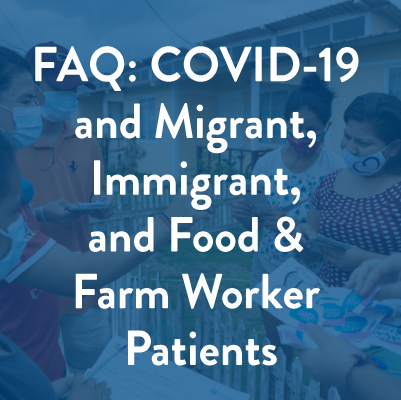- Who We Are
- Clinician Employment
- Publications
- Witness to Witness (W2W)
- Kugel & Zuroweste Health Justice Award
- Your Voice Matters: Photovoice Project
Tue, 12/01/2020 | by Laszlo Madaras


[Editor’s Note: Here, Migrant Clinicians Network’s Chief Medical Officer, Laszlo Madaras, MD, MPH, shares his encounters with AIDS as a doctor, from Africa to the US, to commemorate World AIDS Day and to reflect on one of his #HeroesOnTheFrontline, Dr. Jonathan Mann. Today, Migrant Clinicians Network celebrates #HeroesOnTheFrontline like Dr. Mann, as well as Dr. Madaras, who has been serving vulnerable patients for decades, and is presently treating COVID-19 patients in his hospital in Pennsylvania. Please support frontline clinicians by donating to MCN for today’s #GivingTuesday.]
Mild-mannered in person, Dr. Jonathan Mann could be a passionate speaker. In 1989, at an AIDS Action Committee dinner in Boston, he said: ''In the last few years we have gained confidence that as individuals and all together we are not condemned passively to allow the disease AIDS or the fears and forces which it can unleash to dominate us. Against AIDS we will prevail together, for we will refuse to be split, or to cast into the shadows those persons, groups, and nations that are affected.''
We have come a long way since the first days of HIV. On World AIDS Day, we remember this once new, unknown disease that was taking a lot of young lives starting in the early 1980s. On my college molecular biology exam around 1981- 82, the correct answer for those most vulnerable to this disease (then called human T-cell lymphotropic virus or HTLV-3) were known by the 3 H's: Homosexuals, Haitians, and Hemophiliacs. This was a callous answer that pointed to communities in which transmission at that time was the greatest – but it illustrated how little we knew at the time. We were not sure at the time whether this disease would be spread by mosquitoes in Africa, and there was some concern that perhaps vaccines may have accidentally transmitted this disease. There was a lot of fear and ignorance then, and it does remind me of the present-day SARS-COV–2 virus fear and panic, as our understanding of COVID-19 is still in its first year.
When I served in the Peace Corps in central Africa in the mid 1980s, the Democratic Republic of the Congo – then Zaire -- was thought to be the "hot bed" of this disease which was soon renamed HIV. Our amazing and warm-hearted Peace Corps Country Director had lived in Zaire since childhood and was fluent in several of her languages. He was also a hemophiliac who often required blood transfusions, which finally cost him his life since we could not screen for HIV in the blood supply back then. Many talented Congolese musicians sang about the dangers of transmitting HIV/AIDS (SIDA in French) and making it known that it was also heterosexually transmitted.
When I began medical school, the drug AZT was the first and only medication available. It could not cure HIV/AIDS but it was able to prolong life and reduce some of the viral load and thus transmission between people. Still, many of the young men and women of my generation lost their lives to this terrible disease in the last two decades of the 20th century.
When I started to work as a family physician doing OB with Dr. Ed Zuroweste and Candace Kugel (names our MCN followers may recognize -- both MCN cofounders and still hard at work with us today) at our Keystone Community Health Center, we delivered some of the first HIV-positive mothers on AZT and sent the babies home with nevirapine and a prayer. Fortunately, most babies did not contract HIV from their mothers.
Gradually the drug regimen for HIV and AIDS grew and developed into a complicated concoction of protease inhibitors, integrase inhibitors, and a buffet of various combinations which now required HIV to be an infectious disease subspecialty of its own. Only recently did the combination of medications get simplified in the daily number of pills. What a patient has to take now is minimal and more widely available compared to previous decades.
Vaccines are important, yet even without a vaccine, HIV became a manageable chronic disease.
In 2019, at the United Nations Summit on Global Health in New York, I learned of the great progress in health that some countries such as Rwanda are making. So many have worked hard to make HIV a manageable chronic disease, which was a future that was once unimaginable. I listened in the audience to some of the heroes who put together the blueprints to prevent HIV from becoming what we feared it would become in the 1980's. One of those heroes was missing – W.H.O. director of HIV Dr. Jonathan Mann -- who I had first met in Zaire in 1984, and who later mentored me in medical school in Boston, but whose life was cut short in a plane crash in 1998. Many have given their lives in one way or another in this cause.
I give thanks to all the clinicians and activists who move forward our understanding, compassion, and treatment of HIV/AIDS over the past 40 years. The world is a better place for that, and I hope someday what Dr. Jonathan Mann said in Boston in 1989 we will be able to say about COVID-19.
Like what you see? Amplify our collective voice with a contribution.
Got some good news to share? Contact us on our social media pages above.
Return to the main blog page or sign up for blog updates here.







